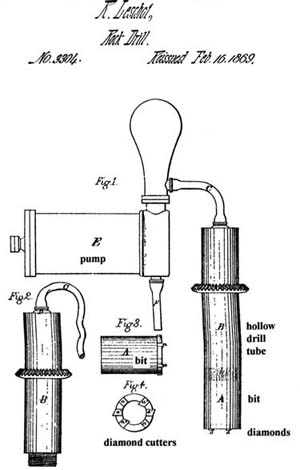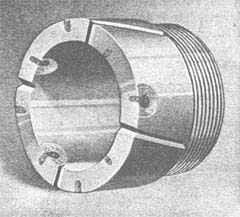 |
||||||
Inventor and History
The diamond core drill was invented and put to practical use in 1863 by Rodolphe Leschot, a French engineer. He used it for drilling blast holes for tunneling Mount Cenis on the France-Italy border. Leschot patented the device in the United States in 1863 and it was reissued in 1869 (Brantly 1971). In 1869 a Leschot diamond drill was shipped to the United States for use in a marble quarry in Vermont (Edson, 1926). It is not known if there is any connection between the 1865 experimental diamond core drilling in the Pennsylvania oil region and the Leschot blast hole drilling in France in 1863. A direct connection does not seem likely.
Most any oil well device has a precursor in antiquity. A type of diamond rotary drilling was used 5000 years ago in Egypt to quarry stone. A hollow wooden rod (later metal) hardened by fire was rotated by hand or bow string on loose, hard mineral grains such as granulated rubies or sapphires which were sifted onto the drill surface. Short holes of about 6 inches, and at least one example of 20 feet were drilled in this way. Ruby and sapphire are species of corundum which is number nine on Moh's scale of hardness. Glass (quartz) is number seven and diamond is number ten which is the hardest mineral and would cut through any hard rock.
The 1865 experimental diamond core drills as well as the earlier one by Leschot consisted of a hollow tube or cylinder having a number of stones set on the bit end. The idea of using jewels or stones as cutting faces came from Leschot's early experience as a watchmaker, a concept which he successfully applied as a tunnel engineer. Leschot's diagram for the reissue of his drill shows that the bit had six stones. Morris (1865) says six stones and Eaton (1866) says fifteen in the tools they described of the experimental oil well(s) in the oil region. Edson (1926) states that the average number used in bits in the 1920's were eight. Setting the stones was the work of a highly skilled expert. The stones are carbonados (black diamonds) or South African borts, the latter being preferred. Leschot may have used clear diamonds of jewel grade at first (his Brazilian stones).
|
||
|
![]()
| © 2004, Samuel T. Pees all rights reserved |
|

